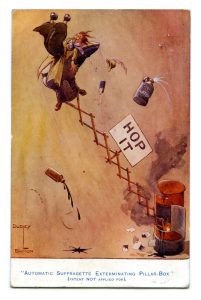As summer holidays continue, Royal Mail is exploring the “Great British holiday tradition” of postcards with an online exhibit.
According to the British postal service, the first recorded postcard was sent by writer and practical joker Theodore Hook in 1840. More recently, in 2002, the postcard sold at auction for £31,750.
The idea didn’t take off until 30 years later, when postcards were released with a half-penny stamp printed as part of the design. By 1894, they were so popular that postcards without a stamp were allowed in the post.
“For over 100 years people up and down the country have been sending postcards home when they are away. A postcard is not only a snapshot of a carefree time but also a permanent reminder of exploring faraway lands,” said Stephen Agar, managing director of Consumer and Network Access. “It is fascinating to think that what started out as a practical joke is now a part of the fabric of summer holidays.”

This circa 1913 colour postcard with an image by Dudley Buxton shows a woman being ejected from a burning pillar box by a large boot on a concertina. (Photo by Royal Mail)
PICTURE POSTCARDS
Picture postcards began to circulate in the early 1900s. They initially featured images of the Boer War and royal outings and were used to update people on current events. The inclusion of a picture led to the creation of the postcard format we recognize today—the image on the front, and the address and message on the back.
Between 1905 and 1915, more than 750 million postcards were sent in Britain every year—the equivalent of 2 million a day. This boom was a result of the rapidly expanding postal service and advances in public transport which enabled people to travel further afield.
COLOURFUL ESCAPE FROM WWI
After the First World War, colourful comic images provided some escapism from the pressures of battle. Consumers embraced the saucy cartoons, which many regard as the “golden age of the picture postcard,” with sales hitting 16 million a year by the early 1930s. The passion for the colourful, and often bawdy-in-nature postcards gave rise to deltiology—the practice of collecting and studying postcards.
Postcards were not printed in great numbers again until the late 1940s, at which point the war effort had stopped consuming most of Britain’s resources.
CHROME ERA
The Chrome postcard era began around 1950, when new printing methods enabled printers to produce high-quality images that looked like a real photograph. These types of postcards remain the most popular today and can be seen in thousands of shops across Britain, according to Royal Mail.
To see how postcards have changed over the decades, visit gallery.royalmailgroup.com/historyofpostcards.

